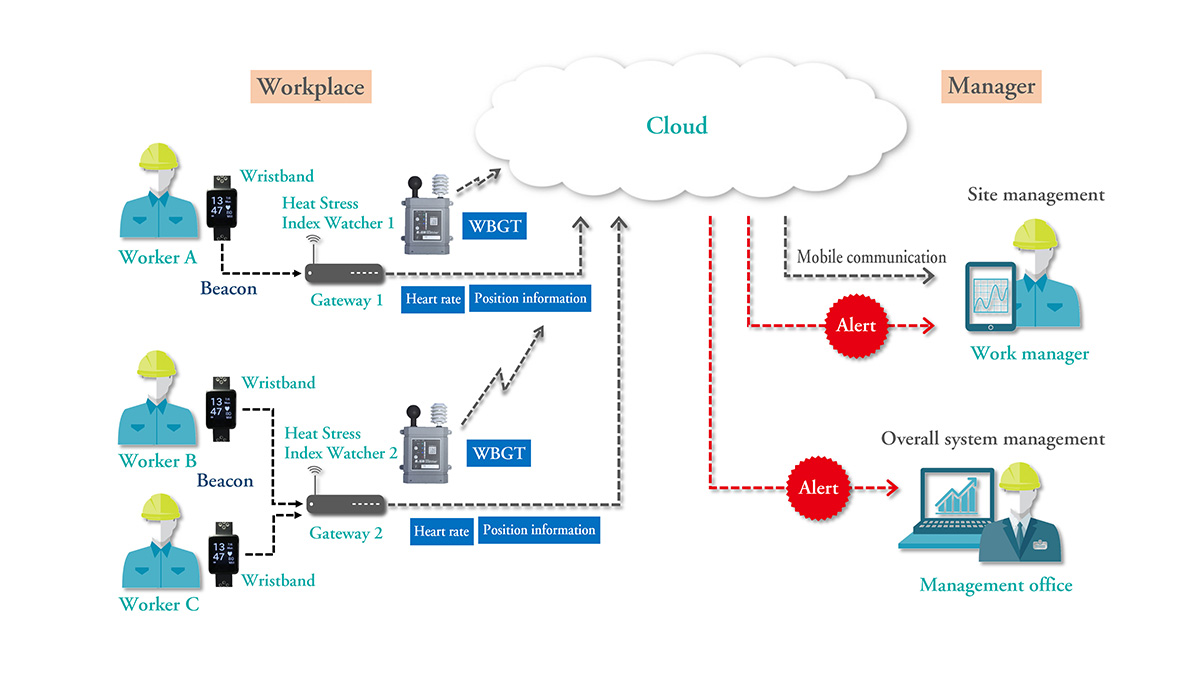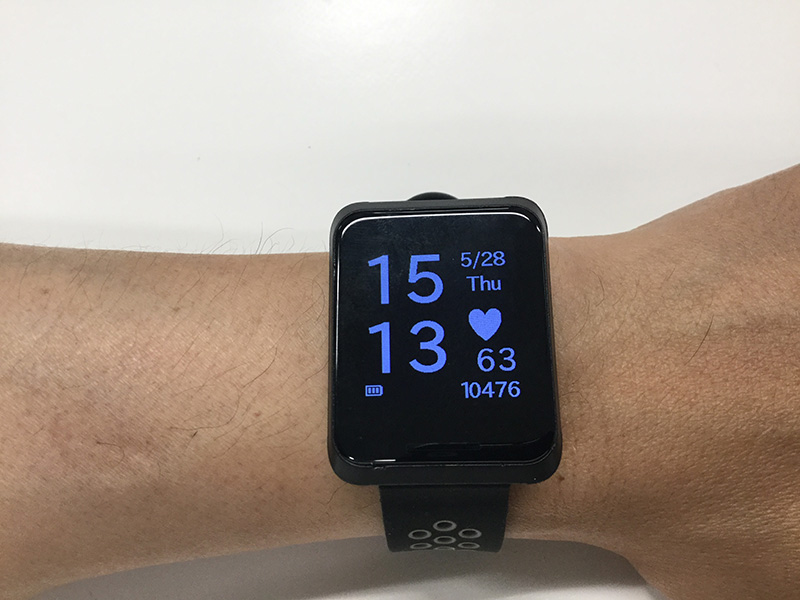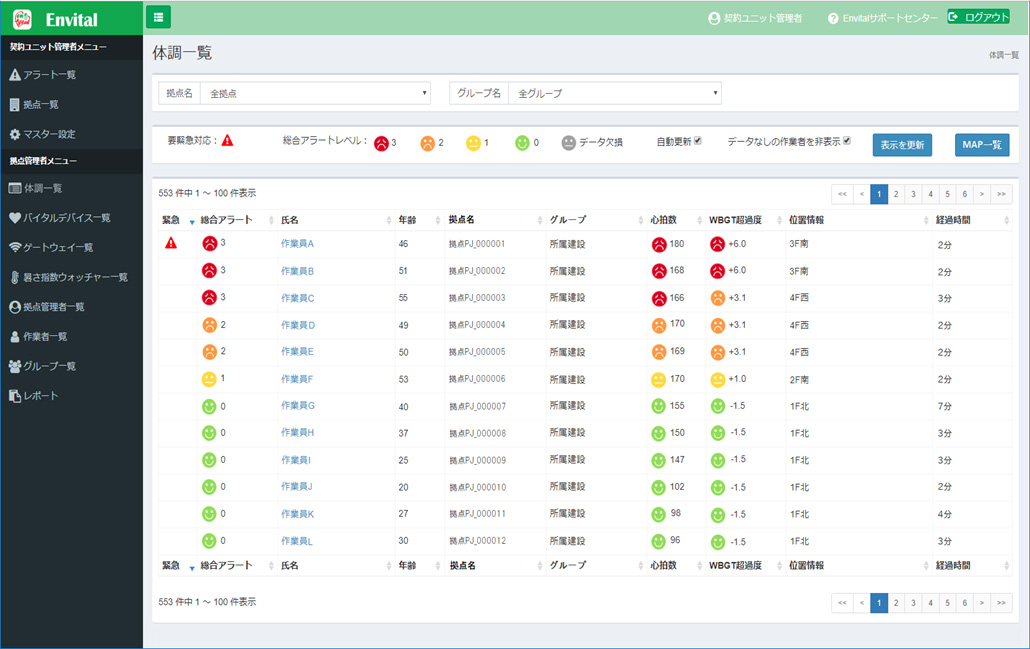- 4 Technology
- Technology Development
Envital, a Smartphone-Free System That Uses Wristband Vital Sensors
We have renewed the vital sensors of Envital®, our physical condition management system for workers, to eliminate the need for smartphones.
All workers have to do is wear wristbands. Easily implement physical condition management.
Obayashi Corporation has renewed Envital, its system for centrally managing the health conditions of workers at construction sites and factories as well as the environmental situations of such sites—thereby managing the physical conditions of workers—by changing the vital sensors that make up the system, improving the system’s management functions, and making other improvements.

In recent years, as measures to deal with record-breaking heat waves become an issue—in order to ensure the safety of workers at construction sites—it has become increasingly important to comprehensively manage and optimally handle the physical strength and condition of each worker as well as work details and workplace environment differences. To respond to this issue, Obayashi Corporation developed Envital in 2015 and then started promoting the system’s full-scale operation in 2017.
Recently, we changed the system from the conventional shirt-type vital sensors to wristband heart rate sensors (called wristbands below) and started installing relays (called gateways below), which are used to send received heart rate data (called vital data below) to a cloud system (called the cloud below), at construction sites in order to eliminate the need to use smartphones as communication devices. In addition, we greatly improved the system’s convenience and effectiveness, such as by starting to acquire location information through the gateway and adding emergency alert functions based on know-how cultivated through operations up until now.
The features of the upgraded Envital system are described below.
-
Improving convenience by eliminating the need for smartphones, and acquiring on-site location information
With the conventional approach, smartphones were used as communication devices to send vital data to the cloud. Therefore, workers and managers had to put up with the inconvenience of carrying smartphones while working, the hassle of logging in to and out of the system, and charging and management work.
With the upgraded system, vital data is sent by using wristbands that continuously transmit three types of beacon signals with different arrival distances (short: 30 m, medium: 100 m, and long: 300 m).
Wristband heart rate sensor By setting up a gateway at the site, which is used to receive the beacon and transmit data to the cloud, acquired vital data can be sent to the cloud without any need to carry a smartphone. Therefore, as long as the workers turn on their wristbands when they start working, vital data can be acquired and sent, which greatly improves convenience. As a result, there is no longer a need to worry about smartphone operational mistakes or running out of battery power, and the new system can be used at sites where it is prohibited to bring smartphones inside factories.
In addition, based on the gateway position and the result of judging whether received beacon signals are coming from a short, medium, or long distance, the location of workers transmitting the signals on the site can be understood. Furthermore, by linking Heat Stress Index Watcher®, which measures environmental data, with the gateway, workers can be automatically linked to environmental data values pertaining to their surroundings. Because data linkage—which once had to be done manually whenever the workplace changed—is now updated automatically, the system enables physical condition management that uses the right environmental data for the target work range without having to do any extra work. -
Addition of emergency alerts that use operational data
Up until now, Obayashi Corporation has introduced Envital at a total of 67 construction sites, factories, and other locations—including external sales—and we have acquired the vital data of over 2,000 people (based on the results up through 2020). In addition, we have analyzed this vital data as well as physical condition questionnaires filled out by workers, and we have compiled a knowledge base of many examples of cases where workers might get sick if they work for a certain length of time while exceeding specific thresholds. Based on the above, in cases where our set biological data and environmental data thresholds are exceeded, overall alerts are issued. In addition, we have utilized the above knowledge by adding functions that display emergency alerts and send emergency alert emails in cases where thresholds are exceeded for a certain length of time. This enables more detailed handling of workers for whom emergency alerts have been issued at each workplace, including getting them to quickly take breaks or replenish their water and salt.

Worker's physical condition list screen To collect and analyze vital data and environmental data, we use Things Cloud®, an IoT platform service provided by NTT Communications Corporation, due to its compatibility with the new wristbands, its ability to handle a lot of data, and the ease with which functions can be expanded and data can be linked to the cloud.
A cloud-based management and analysis system that measures heart rate data (vital data) from vital sensors as well as the humidity, temperature, and other environmental data from Heat Stress Index Watcher. When specific thresholds are exceeded, the system issues alerts to managers and workers regarding water and salt replenishment, etc. Note that Envital is not medical equipment, and it is not intended for any purpose related to disease medical examinations, treatment, recovery, or prevention.
A communication system developed by NTT Communications. By including heart rate information in beacon signals with multiple different arrival distances and sending them, it is possible to acquire heart rates and estimate their location without having to set up a lot of sensors for receiving the signals. This technology is patent pending, including patent number 5376809 and unexamined patent application number 2019-20170.
A system developed by Obayashi Corporation for continuously measuring the heat stress index at multiple workplace locations and centrally managing this information on the cloud.
An IoT platform provided by NTT Communications. This platform provides functions and templates capable of easily and quickly achieving all the functions and processes necessary for IoT introduction, from connecting devices to the collection, visualization, analysis, and management of data, without any need for programming.
- Management and
Organization- The Articles of Incorporation
- Basic Principles
- Transitioning of Corporate Symbol
- Corporate Officers
- Organization Chart
- Stock Information
- Financial Statements
- Technology
- BIM Timeline
- Awards
- Major Publication
- Group Companies
- Group Companies (in Japan)
- Group Companies (Overseas)